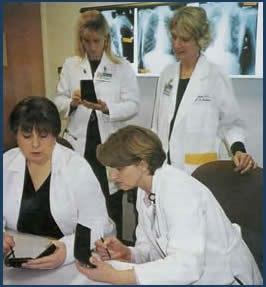|
The
first SON to require the use of PDAs
|
University of Virginia School of Nursing

Arlene Keeling, RN, PhD, Audrey Snyder,RN, ACNP, ACNP & Suzanne
Burns, RN, ACNP, all of the Virginia
SON have made history by making the use of mobile computing
a requirement in both the acute and primary care nurse practitioner
programs.
Early in 2000, Arlene Keeling, the director of the Acute Care Nurse
Practitioner program and her co-investigator Audrey Snyder, conceived
the idea to introduce mobile computing to the school of nursing.
Arlene had noticed a group of student nurses fumbling through their
lab coat pockets which were overflowing with notepads, and snippets
of paper, looking for their dog-eared, outdated pharmacology reference
texts. She started thinking that there must be a better way of doing
things.
There was a time, not that long ago, when nursing students could
reasonably expect that the information and theory contained in their
drug reference texts would remain relevant for years to come. Not
any more. In today's furiously changing healthcare environment,
old ideas, paradigms and information are being overturned and replaced
with regularity. The result: the shelf life of the average drug
reference has shrunk dramatically.
Arlene knew that if nursing schools continued in their use of the
paper bound reference materials they would be graduating nurses
with equally outdated and obsolete information and skills. She then
set out to bring nursing education into the 21st century. Handheld
computers caught her attention as a possible solution to the dilemma.
The SON applied for and received a grant from the University of
Virginia Alumni Association to implement their innovative teaching
methods utilizing handheld devices in the graduate NP program. In
the initial grant, provisions were made to loan the students handheld
computers to use for the semester, and while they were involved
in clinical course work supervised by Suzanne Burns. (In the Spring
of 2001 all NP students taking the advanced pharmacology course
taught by Shelley Huffstuttler and Audrey Snyder were required to
purchase their own handheld in place of the standard reference texts.)
Early planning included assisting the faculty in use of these devices.
Thanks to a donation from Palm, the faculty had access to 8 handheld
computers. This afforded the faculty an opportunity to learn firsthand
about the highest and best use of handhelds. Additionally the faculty
had the opportunity to trial a variety of programs prior to making
a decision on what reference materials the students should be required
to use.
Initially the NP students were to use ePocrates and the Tarascon
ePharmacopoeia for their mobile drug references. However the school
is currently investigating nursing specific drug references such
as Lexi-Comp's NursingDrugs.
Students comments have been more than favorable, regardless of
the initial learning curve required to master the devices:
Students participated in a post use survey questionnaire where
they are asked for examples where the handheld was valuable. A compleling
example was cited by a NP student in her ER rotation.
-
A baby was brought into the ER and immediately had a generalized
seizure. The staff, aware that the ACNP student used a handheld
computer, asked if she would check the correct pediatric dosing
for Dilantin. What would normally have taken time to access
via the "normal channels" of asking the pharmacist
or leaving the room to check a reference book, was accessed
with a few pen strokes in less than two minutes.
Future uses for the PDA are coming to fruition. Examples are programs
that cluster symptoms and provide information on differential diagnoses,
resuscitation application, and lab value norms. The newest use will
be mobile wireless connection for the latest in clinical literature
and studies that can be rapidly accessed anywhere, anytime. Handheld
database development is also under consideration. Decreasing faculty
time for tracking student, experiences/procedures etc., is a possibility,
information could be beamed with a bi-directional response as to
schedule changes or site assignments. Using their innovative imagination,
the faculty and students will create limitless possibilities for
use of their PDAs.
These NP students are society's future primary health care providers.
As they enter the healthcare arena they will bring firsthand knowledge
and experience with mobile devices along with the ability to access
resources that technology provides. They will possess the skills
necessary to compete in today's revenue seeking and cost containment
healthcare model along with compliance knowledge for current and
future regulations.
Sylvia Suszka-Hildebrandt,
MN, ARNP, Editor PDA cortex
.gif)
|

![]()